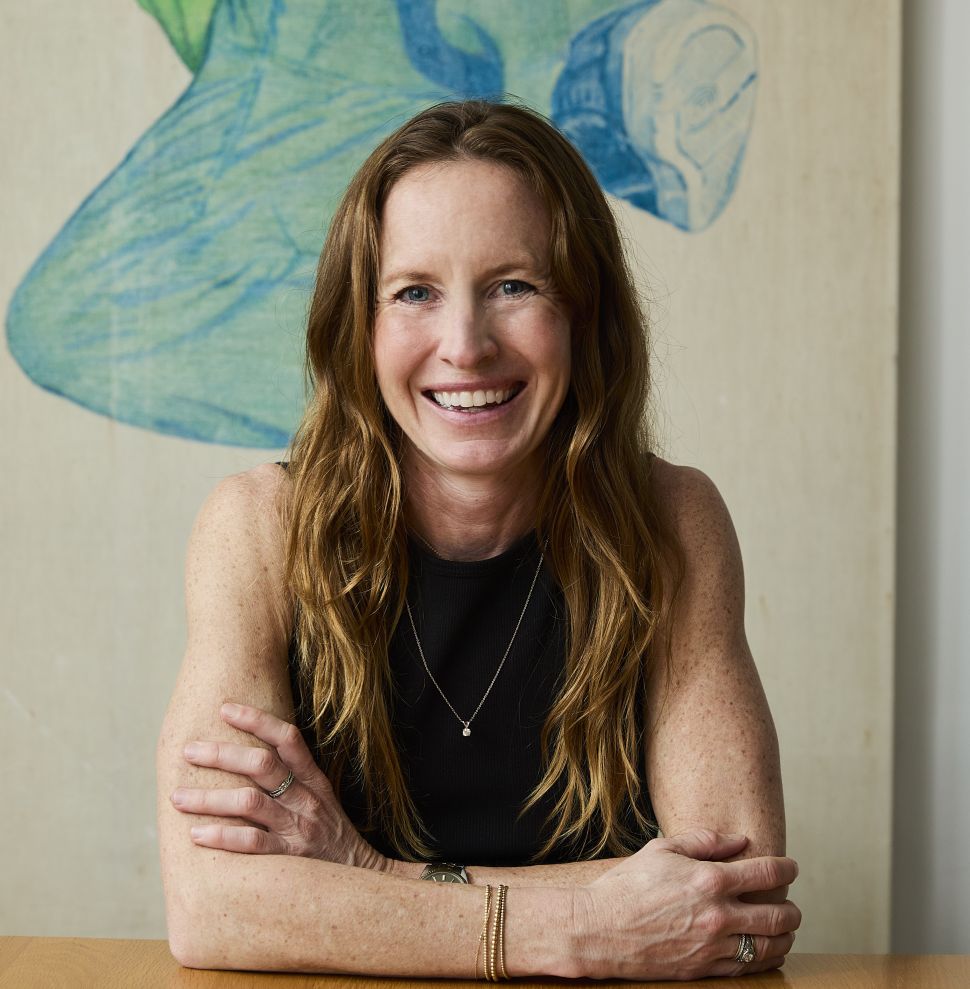Kelly Freeman seated at a wooden table, smiling with arms crossed in front of a large artwork showing a figure in blue jeans and a green shirt in the background” width=”970″ height=”989″ data-caption=’Kelly Freeman is cautiously optimistic about where the art market is headed. <span class=”lazyload media-credit”>Photo: Genevieve Garruppo</span>’>
This week marks the opening of the 13th edition of the San Francisco Art Fair. Formerly known as ArtMRKT San Francisco, the fair has helped pioneer the city’s burgeoning art market. These days, San Francisco is trying to win back the tech elite who left during the pandemic, with the mayor pitching the city’s culture as a reason to return just this week. We sat down with director Kelly Freeman to hear more about the fair and the city’s cultural life.
The art market is in a curious place right now! How do you feel going into this fair?
I’m cautiously optimistic, which if you know me, shouldn’t come as much of a shock. In my opinion, San Francisco Art Fair exemplifies the art world’s ability to adapt and thrive alongside an ever-shifting global market. The current economic unpredictability can create opportunity: for discovery, for new relationships and for reinforcing the strength of the Bay Area arts ecosystem. We’re going into this year feeling energized. The fair is doubling down on the Bay, and with eighty-eight exhibitors and forty-five cultural partners, it’s a moment to showcase just how resilient and innovative this community is.
What’s the San Francisco art market like in general? Could you compare it to Los Angeles or New York? What sorts of folks in San Francisco like to buy in San Francisco?
San Francisco’s market feels deeply community-oriented. The Bay tends to attract curious, engaged collectors who want to support artists reflecting the region’s values—whether that’s social impact, environmental awareness or experimental practices. The focus isn’t solely on price points—it’s about accessibility, cultural depth and a commitment to supporting a diverse range of mediums and artists who mirror the Bay’s unique character.
This marks the 13th edition of the fair. What have you learned about doing this fair in that time?
Over the past 13 editions, one key lesson has been the importance of staying in lockstep with San Francisco’s evolution. The fair has grown alongside the city’s artistic shifts—from galleries moving into historically underserved neighborhoods to welcoming new, innovative exhibitors. We’ve learned that fostering an environment where established and emerging voices can interact creates a truly dynamic experience. It’s a testament to our commitment to being more than a showcase—it’s a community hub that continuously reinvents itself to reflect the city’s vibrancy.
This year’s fair focuses on East Bay creativity, with a section curated by Brock Brake of pt.2 Gallery. Can you tell me more about that section and East Bay creativity more broadly?
The East Bay has always been a powerhouse of community-driven creativity. Within Brock Brake’s curation of this year’s special section, he’s shining a much-deserved spotlight on artists like Alicia McCarthy and Ryan Whelan—voices that reflect the authenticity and collaborative energy of Oakland and beyond. We’re also thrilled to collaborate with institutions like NIAD and the Berkeley Art Museum to show how vital East Bay’s contributions are to the broader Bay Area arts ecosystem.
I’m sure it’s hard to pick, but what are some of this year’s standout booth presentations that visitors should be sure not to miss?
It is hard to pick, but I want to spotlight a few standout presentations, especially from our first-time exhibitors. Jessica Silverman’s booth features Clare Rojas and Chelsea Ryoko Wong—two artists whose practices are deeply rooted in the Bay. Speaking of the East Bay, Wong currently has a beautiful exhibition on view at the Oakland Museum. Also not to miss: Anthony Meier’s presentation of Saif Azzuz and Jesse Schlesinger and Micki Meng’s moving project of fifty canvases created by artists, activists and environmentalists in support of land protection. She confirmed contributions from Chris Bedford, director of SFMOMA; Bob Fisher, board chair of SFMOMA; and Ali Gass, director of ICA San Francisco—all of whom are participating with works.
SEE ALSO: MASP’s Expansion Opens the Floor to Curatorial Experimentation
Relatedly, this edition’s programming feels very strong. “Motherhood & Art” sounds like a fascinating panel. What are some other highlights from the programming aspect of the fair?
The “Motherhood & Art” panel is one of my favorite conversations we’re hosting this year. It highlights artists navigating the dual identities of motherhood and making. We’ve partnered with Katie Hintz-Zambrano, founder of Mother Magazine, to moderate the panel—she has long championed the creative work of mothers. It’s the kind of discussion we’re proud to present: personal, urgent and too often overlooked.
Beyond that, we’re exploring other timely and thought-provoking topics—like how artificial intelligence is transforming the artist’s studio, collecting Black art and how institutions focused on historically excluded groups are responding to the current political moment. Together, our programming reflects a commitment to presenting not just artwork but also the critical conversations shaping its future.
What might people be surprised to learn about the San Francisco art scene?
That it’s not just surviving—it’s thriving. There’s this narrative that San Francisco has lost its creative edge, but when you spend time in the city, you’ll see that it couldn’t be further from the truth. Artists here are innovating, collectors are showing up and institutions—large and small—are pushing boundaries. It’s a dynamic, inclusive ecosystem where art is accessible and reflects the region’s cultural tapestry. The fair becomes a true celebration of that vitality, nurturing local talent and sparking new conversations.

